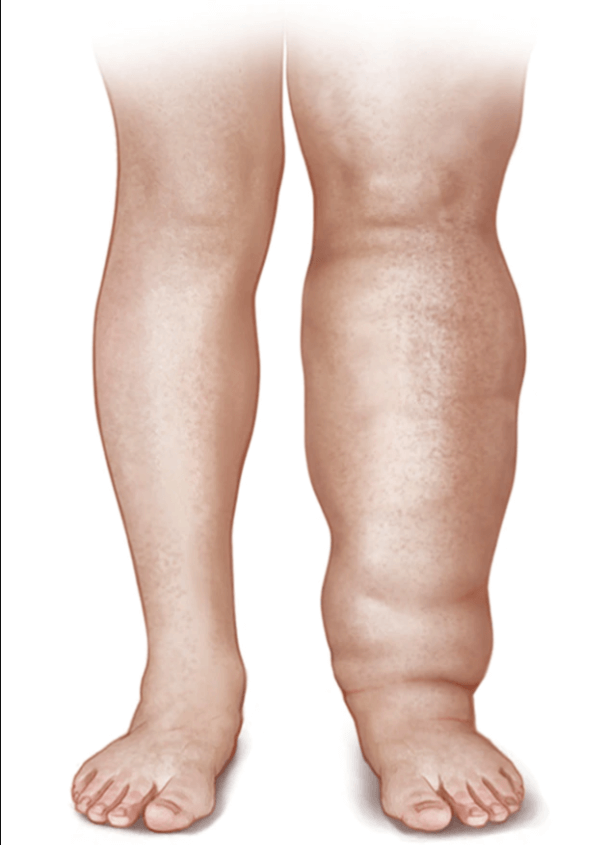Lymphatic diseases
lymphedema
What is lymphedema?
Lymphedema is swelling that usually appears in one of your arms or legs. Sometimes both hands or both feet swell.
Lymphedema is most often caused by the removal or damage to your lymph nodes as part of cancer treatment. This is the result of a blockage in your lymphatic system, which is part of your immune system. The blockage prevents the lymphatic fluid from draining well, and the accumulation of fluid leads to swelling.
Although there is currently no cure for lymphedema, it can be controlled with early diagnosis and thorough care of your affected limb.
When to see a doctor?
Make an appointment with your doctor if you notice persistent swelling in your arm or leg.
If you already have the diagnosis of lymphedema of a limb, consult your doctor if there is a sudden sharp increase in the size of the affected limb, as this may be starting a new process.
What are the symptoms?
Signs and symptoms of lymphedema that appear in your affected arm or leg include:
Swelling of part or all of an arm or foot, including fingers
Feeling heavy or tight
Restriction of movements
Pain or discomfort
Recurrent infections
Hardening of the skin (fibrosis)
The swelling caused by lymphedema ranges from mild, hardly noticeable changes in arm or leg size to extreme changes that make the limb difficult to move. Lymphedema caused by cancer treatment may not occur until months or years after treatment.
What are the reasons?
Your lymphatic system is crucial to maintaining the health of your body. Protein-rich lymphatic fluid circulates throughout your body, collecting bacteria, viruses and waste products. Your lymphatic system carries this fluid and harmful substances through your lymphatic vessels, resulting in lymph nodes. The waste is then filtered by the lymphocytes infection-fighting cells that live in your lymph nodes and eventually excreted from your body.
Lymphedema occurs when your lymphatic vessels are unable to adequately carry away lymphatic fluid, usually from your arm or leg. Lymphedema can be primary or secondary. This means that it can occur on its own (primary lymphedema) or it can be caused by another disease or condition (secondary lymphedema). Secondary lymphedema is much more common than primary lymphedema.
Causes of secondary lymphedema
Any condition or procedure that damages your lymph nodes or lymphatic vessels can cause lymphedema. Causes include surgery, cancer, infections, cancer treatment.
Causes of primary lymphedema
Primary lymphedema is a rare, inherited condition caused by problems with the development of lymphatic vessels in your body.
Risk factors
Factors that may increase the risk of developing lymphedema after cancer, cancer treatment, or other secondary causes include:
• Advanced age
• Overweight or obesity
• Rheumatoid or psoriatic arthritis
Diagnostics
Diagnosis of lymphedema is carried out by a number of imaging tests. These may include:
MRI Scan
CT Scan
Doppler Ultrasound
Radionuclide image of your lymphatic system (lymphoscintigraphy)

Treatment
Treatment focuses on reducing swelling and controlling pain. Treatment of lymphedema includes:
Exercises. Soft exercises in which you move your affected limb can promote lymphatic fluid drainage. Exercise should not tire you, but you should focus on slightly contracting the muscles in your arm or leg.
Bandage on the arm or leg. Bandaging the entire limb encourages lymphatic fluid to drain back. The bandage should be tightest around your fingers and loosen up your arm or leg.
Massage. A special massage technique called manual lymphatic drainage can promote the drainage of lymphatic fluid from the arm or leg. Massage is not suitable for everyone. Avoid massage if you have a skin infection, blood clots, or active illness in the affected areas of lymphatic drainage.
Elastocompressive therapy. Long sleeves or socks made to compress the arm or leg promote the outflow of lymphatic fluid from the affected limb.
Comprehensive decongestive therapy. This approach involves combining therapies with lifestyle changes. In general, this therapy is not recommended for people with high blood pressure, diabetes, paralysis, heart failure, blood clots, or acute infections.
